Morphological, Spectroscopic and Thermal Analysis of Cellulose Nanocrystals Extracted from Waste Jute Fiber by Acid Hydrolysis
Abstract
:1. Introduction
2. Materials and Method
2.1. Raw Materials’ Collection
2.2. Extraction of Pure Cellulose
2.2.1. Pretreatment of Raw Jute Fibers
2.2.2. Alkali Treatment of Jute Fiber with Anthraquinone
2.3. Synthesis of Cellulose Nanocrystals (CNCs) by Acid Hydrolysis
2.4. Characterization of Prepared Cellulose Nanocrystals (CNCs)
2.4.1. Particle Size Distribution (PSDs) and Zeta Potential
2.4.2. Fourier Transform Infrared Spectroscopy (FTIR)
2.4.3. X-ray Diffraction (XRD)
2.4.4. Thermal Analysis
2.4.5. Atomic Force Microscopy (AFM)
3. Results and Discussion
3.1. Particle Size and Particle Size Distribution (PSDs) of Prepared Samples
3.2. Zeta Potential of CNC Suspensions
3.3. FTIR Analysis of the CNC Samples
3.4. X-ray Diffraction (XRD) Analysis
3.5. Thermogravimetric (TGA) Analysis
3.6. Differential Thermal Analysis (DTA)
3.7. Atomic Force Microscopy (AFM) Analysis
4. Conclusions
Author Contributions
Funding
Institutional Review Board Statement
Data Availability Statement
Acknowledgments
Conflicts of Interest
References
- Han, X.; Ding, L.; Tian, Z.; Song, Y.; Xiong, R.; Zhang, C.; Han, J.; Jiang, S. Potential New Material for Optical Fiber: Preparation and Characterization of Transparent Fiber Based on Natural Cellulosic Fiber and Epoxy. Int. J. Biol. Macromol. 2023, 224, 1236–1243. [Google Scholar] [CrossRef] [PubMed]
- Han, X.; Ding, L.; Tian, Z.; Wu, W.; Jiang, S. Extraction and Characterization of Novel Ultrastrong and Tough Natural Cellulosic Fiber Bundles from Manau Rattan (Calamus Manan). Ind. Crop. Prod. 2021, 173, 114103. [Google Scholar] [CrossRef]
- Habibi, Y.; Lucia, L.A.; Rojas, O.J. Cellulose Nanocrystals: Chemistry, Self-Assembly, and Applications. Chem. Rev. 2010, 110, 3479–3500. [Google Scholar] [CrossRef]
- George, J.; Sabapathi, S.N. Cellulose Nanocrystals: Synthesis, Functional Properties, and Applications. Nanotechnol. Sci. Appl. 2015, 8, 45–54. [Google Scholar] [CrossRef] [PubMed] [Green Version]
- Brinchi, L.; Cotana, F.; Fortunati, E.; Kenny, J.M. Production of Nanocrystalline Cellulose from Lignocellulosic Biomass: Technology and Applications. Carbohydr. Polym. 2013, 94, 154–169. [Google Scholar] [CrossRef]
- Donald, A.M. Polysaccharide Crystallization. In Encyclopedia of Materials: Science and Technology; Elsevier: Amsterdam, The Netherlands, 2001; pp. 7714–7718. [Google Scholar]
- Ergun, R.; Guo, J.; Huebner-Keese, B. Cellulose. In Encyclopedia of Food and Health; Elsevier: Amsterdam, The Netherlands, 2016; pp. 694–702. [Google Scholar]
- Lavanya, D.; Kulkarni, P.; Dixit, M.; Raavi, P.K.; Krishna, L.N.V. Sources of Cellulose and Their Applications—A Review. Int. J. Drug. Formul. Res. 2011, 2, 19–38. [Google Scholar]
- Nunes, R.C.R. Rubber Nanocomposites with Nanocellulose. In Progress in Rubber Nanocomposites; Elsevier: Amsterdam, the Netherlands, 2017; pp. 463–494. [Google Scholar]
- Kusmono; Listyanda, R.F.; Wildan, M.W.; Ilman, M.N. Preparation and Characterization of Cellulose Nanocrystal Extracted from Ramie Fibers by Sulfuric Acid Hydrolysis. Heliyon 2020, 6, e05486. [Google Scholar] [CrossRef]
- Peng, B.L.; Dhar, N.; Liu, H.L.; Tam, K.C. Chemistry and Applications of Nanocrystalline Cellulose and Its Derivatives: A Nanotechnology Perspective. Can. J. Chem. Eng. 2011, 89, 1191–1206. [Google Scholar] [CrossRef]
- Trache, D.; Hussin, M.H.; Haafiz, M.K.M.; Thakur, V.K. Recent Progress in Cellulose Nanocrystals: Sources and Production. Nanoscale 2017, 9, 1763–1786. [Google Scholar] [CrossRef] [Green Version]
- Grishkewich, N.; Mohammed, N.; Tang, J.; Tam, K.C. Recent Advances in the Application of Cellulose Nanocrystals. Curr. Opin. Colloid Interface Sci. 2017, 29, 32–45. [Google Scholar] [CrossRef]
- Xie, S.; Zhang, X.; Walcott, M.P.; Lin, H. Applications of Cellulose Nanocrystals: A Review. Eng. Sci. 2018, 2, 4–16. [Google Scholar] [CrossRef]
- Yang, Y.; Chen, Z.; Zhang, J.; Wang, G.; Zhang, R.; Suo, D. Preparation and Applications of the Cellulose Nanocrystal. Int. J. Polym. Sci. 2019, 2019, 1767028. [Google Scholar] [CrossRef]
- Oyeoka, H.C.; Ewulonu, C.M.; Nwuzor, I.C.; Obele, C.M.; Nwabanne, J.T. Packaging and Degradability Properties of Polyvinyl Alcohol/Gelatin Nanocomposite Films Filled Water Hyacinth Cellulose Nanocrystals. J. Bioresour. Bioprod. 2021, 6, 168–185. [Google Scholar] [CrossRef]
- Lam, E.; Hemraz, U.D. Preparation and Surface Functionalization of Carboxylated Cellulose Nanocrystals. Nanomaterials 2021, 11, 1641. [Google Scholar] [CrossRef]
- Yu, X.; Jiang, Y.; Wu, Q.; Wei, Z.; Lin, X.; Chen, Y. Preparation and Characterization of Cellulose Nanocrystal Ex-traction From Pennisetum Hydridum Fertilized by Municipal Sewage Sludge via Sulfuric Acid Hydrolysis. Front. Energy Res. 2021, 9, 774783. [Google Scholar] [CrossRef]
- Cheng, M.; Qin, Z.; Chen, Y.; Hu, S.; Ren, Z.; Zhu, M. Efficient Extraction of Cellulose Nanocrystals through Hydrochloric Acid Hydrolysis Catalyzed by Inorganic Chlorides under Hydrothermal Conditions. ACS Sustain. Chem. Eng. 2017, 5, 4656–4664. [Google Scholar] [CrossRef]
- Amin, K.N.M.; Hosseinmardi, A.; Martin, D.J.; Annamalai, P.K. A Mixed Acid Methodology to Produce Thermally Stable Cellulose Nanocrystal at High Yield Using Phosphoric Acid. J. Bioresour. Bioprod. 2022, 7, 99–108. [Google Scholar] [CrossRef]
- Li, B.; Xu, W.; Kronlund, D.; Määttänen, A.; Liu, J.; Smått, J.-H.; Peltonen, J.; Willför, S.; Mu, X.; Xu, C. Cellulose Nanocrystals Prepared via Formic Acid Hydrolysis Followed by TEMPO-Mediated Oxidation. Carbohydr. Polym. 2015, 133, 605–612. [Google Scholar] [CrossRef] [PubMed]
- Mohd Amin, K.N.; Annamalai, P.K.; Morrow, I.C.; Martin, D. Production of Cellulose Nanocrystals via a Scalable Mechanical Method. RSC Adv. 2015, 5, 57133–57140. [Google Scholar] [CrossRef] [Green Version]
- Alonso-Lerma, B.; Barandiaran, L.; Ugarte, L.; Larraza, I.; Reifs, A.; Olmos-Juste, R.; Barruetabeña, N.; Amenabar, I.; Hillenbrand, R.; Eceiza, A.; et al. High Performance Crystalline Nanocellulose Using an Ancestral Endoglucanase. Commun. Mater. 2020, 1, 57. [Google Scholar] [CrossRef]
- Shamshina, J.L.; Abidi, N. Cellulose Nanocrystals from Ionic Liquids: A Critical Review. Green Chem. 2021, 23, 6205–6222. [Google Scholar] [CrossRef]
- Zhou, Y.; Saito, T.; Bergström, L.; Isogai, A. Acid-Free Preparation of Cellulose Nanocrystals by TEMPO Oxidation and Subsequent Cavitation. Biomacromolecules 2018, 19, 633–639. [Google Scholar] [CrossRef]
- Syafri, E.; Kasim, A.; Abral, H.; Asben, A. Cellulose Nanofibers Isolation and Characterization from Ramie Using a Chemical-Ultrasonic Treatment. J. Nat. Fibers 2019, 16, 1145–1155. [Google Scholar] [CrossRef]
- Li, W.; Yue, J.; Liu, S. Preparation of Nanocrystalline Cellulose via Ultrasound and Its Reinforcement Capability for Poly(Vinyl Alcohol) Composites. Ultrason. Sonochem. 2012, 19, 479–485. [Google Scholar] [CrossRef]
- Kumar, A.; Singh Negi, Y.; Choudhary, V.; Kant Bhardwaj, N. Characterization of Cellulose Nanocrystals Produced by Acid-Hydrolysis from Sugarcane Bagasse as Agro-Waste. J. Mater. Phys. Chem. 2020, 2, 1–8. [Google Scholar] [CrossRef]
- Samanta, A.K.; Mukhopadhyay, A.; Ghosh, S.K. Processing of Jute Fibres and Its Applications. In Handbook of Natural Fibres; Volume 2: Processing and Applications; Elsevier: Amsterdam, The Netherlands, 2020; pp. 49–120. [Google Scholar]
- Jahan, M.S.; Saeed, A.; He, Z.; Ni, Y. Jute as Raw Material for the Preparation of Microcrystalline Cellulose. Cellulose 2011, 18, 451–459. [Google Scholar] [CrossRef]
- Alam, M.M.; Maniruzzaman, M.; Morshed, M.M. Application and Advances in Microprocessing of Natural Fiber (Jute)–Based Composites. Compr. Mater. Process. 2014, 7, 243–260. [Google Scholar]
- Strand, A.; Vähäsalo, L.; Retulainen, E.; Sundberg, A. Analysis of Cellulose Nanocrystals (CNCs) with Flow Cytometry. Cellulose 2019, 26, 959–970. [Google Scholar] [CrossRef] [Green Version]
- Kasyapi, N.; Chaudhary, V.; Bhowmick, A.K. Bionanowhiskers from Jute: Preparation and Characterization. Carbohydr. Polym. 2013, 92, 1116–1123. [Google Scholar] [CrossRef] [PubMed]
- Elazzouzi-Hafraoui, S.; Nishiyama, Y.; Putaux, J.-L.; Heux, L.; Dubreuil, F.; Rochas, C. The Shape and Size Distribution of Crystalline Nanoparticles Prepared by Acid Hydrolysis of Native Cellulose. Biomacromolecules 2008, 9, 57–65. [Google Scholar] [CrossRef]
- de M. Teixeira, E.; Pasquini, D.; Curvelo, A.A.S.; Corradini, E.; Belgacem, M.N.; Dufresne, A. Cassava Bagasse Cellulose Nanofibrils Reinforced Thermoplastic Cassava Starch. Carbohydr. Polym. 2009, 78, 422–431. [Google Scholar] [CrossRef]
- Šturcová, A.; Davies, G.R.; Eichhorn, S.J. Elastic Modulus and Stress-Transfer Properties of Tunicate Cellulose Whiskers. Biomacromolecules 2005, 6, 1055–1061. [Google Scholar] [CrossRef] [PubMed]
- Merlini, A.; Claumann, C.; Zibetti, A.W.; Coirolo, A.; Rieg, T.; Machado, R.A.F. Kinetic Study of the Thermal Decomposition of Cellulose Nanocrystals with Different Crystal Structures and Morphologies. Ind. Eng. Chem. Res. 2020, 59, 13428–13439. [Google Scholar] [CrossRef]
- Benchikh, L.; Merzouki, A.; Grohens, Y.; Guessoum, M.; Pillin, I. Characterization of Cellulose Nanocrystals Extracted from El Diss and El Retma Local Plants and Their Dispersion in Poly(Vinyl Alcohol-Co-Ethylene) Matrix in the Presence of Borax. Polym. Polym. Compos. 2021, 29, 218–230. [Google Scholar] [CrossRef]
- Wu, Q.; Li, X.; Fu, S.; Li, Q.; Wang, S. Estimation of Aspect Ratio of Cellulose Nanocrystals by Viscosity Measurement: Influence of Surface Charge Density and NaCl Concentration. Cellulose 2017, 24, 3255–3264. [Google Scholar] [CrossRef]
- Prasad Reddy, J.; Rhim, J.-W. Isolation and Characterization of Cellulose Nanocrystals from Garlic Skin. Mater. Lett. 2014, 129, 20–23. [Google Scholar] [CrossRef]
- Lin, Z.; Guan, Z.; Huang, Z. New Bacterial Cellulose/Polyaniline Nanocomposite Film with One Conductive Side through Constrained Interfacial Polymerization. Ind. Eng. Chem. Res. 2013, 52, 2869–2874. [Google Scholar] [CrossRef]
- Zhang, X.; Wu, X.; Lu, C.; Zhou, Z. Dialysis-Free and in Situ Doping Synthesis of Polypyrrole@Cellulose Nanowhiskers Nanohybrid for Preparation of Conductive Nanocomposites with Enhanced Properties. ACS Sustain. Chem. Eng. 2015, 3, 675–682. [Google Scholar] [CrossRef]
- French, A.D. Idealized Powder Diffraction Patterns for Cellulose Polymorphs. Cellulose 2014, 21, 885–896. [Google Scholar] [CrossRef]
- Lu, P.; Hsieh, Y.L. Preparation and Characterization of Cellulose Nanocrystals from Rice Straw. Carbohydr. Polym. 2012, 87, 564–573. [Google Scholar] [CrossRef]
- de Oliveira, F.B.; Bras, J.; Pimenta, M.T.B.; da Silva Curvelo, A.A.; Belgacem, M.N. Production of Cellulose Nanocrystals from Sugarcane Bagasse Fibers and Pith. Ind. Crop. Prod. 2016, 93, 48–57. [Google Scholar] [CrossRef]
- Yao, F.; Wu, Q.; Lei, Y.; Guo, W.; Xu, Y. Thermal Decomposition Kinetics of Natural Fibers: Activation Energy with Dynamic Thermogravimetric Analysis. Polym. Degrad. Stab. 2008, 93, 90–98. [Google Scholar] [CrossRef]
- Johar, N.; Ahmad, I.; Dufresne, A. Extraction, Preparation and Characterization of Cellulose Fibres and Nanocrystals from Rice Husk. Ind. Crop. Prod. 2012, 37, 93–99. [Google Scholar] [CrossRef]
- Roman, M.; Winter, W.T. Effect of Sulfate Groups from Sulfuric Acid Hydrolysis on the Thermal Degradation Behavior of Bacterial Cellulose. Biomacromolecules 2004, 5, 1671–1677. [Google Scholar] [CrossRef]
- Silvério, H.A.; Flauzino Neto, W.P.; Dantas, N.O.; Pasquini, D. Extraction and Characterization of Cellulose Nanocrystals from Corncob for Application as Reinforcing Agent in Nanocomposites. Ind. Crop. Prod. 2013, 44, 427–436. [Google Scholar] [CrossRef]
- Li, R.; Fei, J.; Cai, Y.; Li, Y.; Feng, J.; Yao, J. Cellulose Whiskers Extracted from Mulberry: A Novel Biomass Production. Carbohydr. Polym. 2009, 76, 94–99. [Google Scholar] [CrossRef]
- Vanderfleet, O.M.; Reid, M.S.; Bras, J.; Heux, L.; Godoy-Vargas, J.; Panga, M.K.R.; Cranston, E.D. Insight into Thermal Stability of Cellulose Nanocrystals from New Hydrolysis Methods with Acid Blends. Cellulose 2019, 26, 507–528. [Google Scholar] [CrossRef]
- Voronova, M.I.; Surov, O.V.; Rubleva, N.V.; Kochkina, N.E.; Zakharov, A.G. Dispersibility of nanocrystalline cellulose in organic solvents. Russ. J. Bioorg. Chem. 2020, 46, 1295–1303. [Google Scholar] [CrossRef]
- Lahiji, R.R.; Xu, X.; Reifenberger, R.; Raman, A.; Rudie, A.; Moon, R.J. Atomic Force Microscopy Characterization of Cellulose Nanocrystals. Langmuir 2010, 26, 4480–4488. [Google Scholar] [CrossRef] [PubMed]


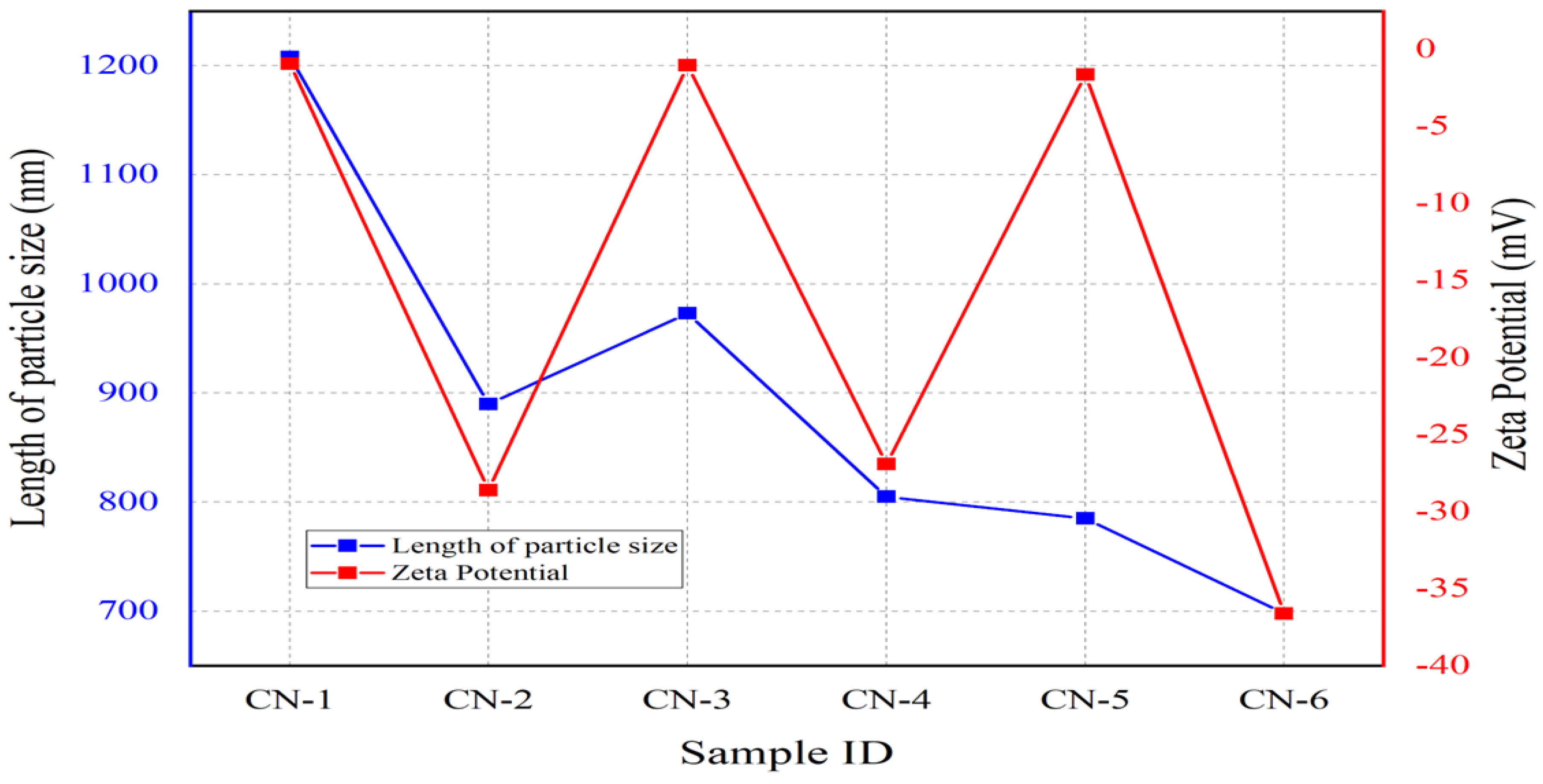


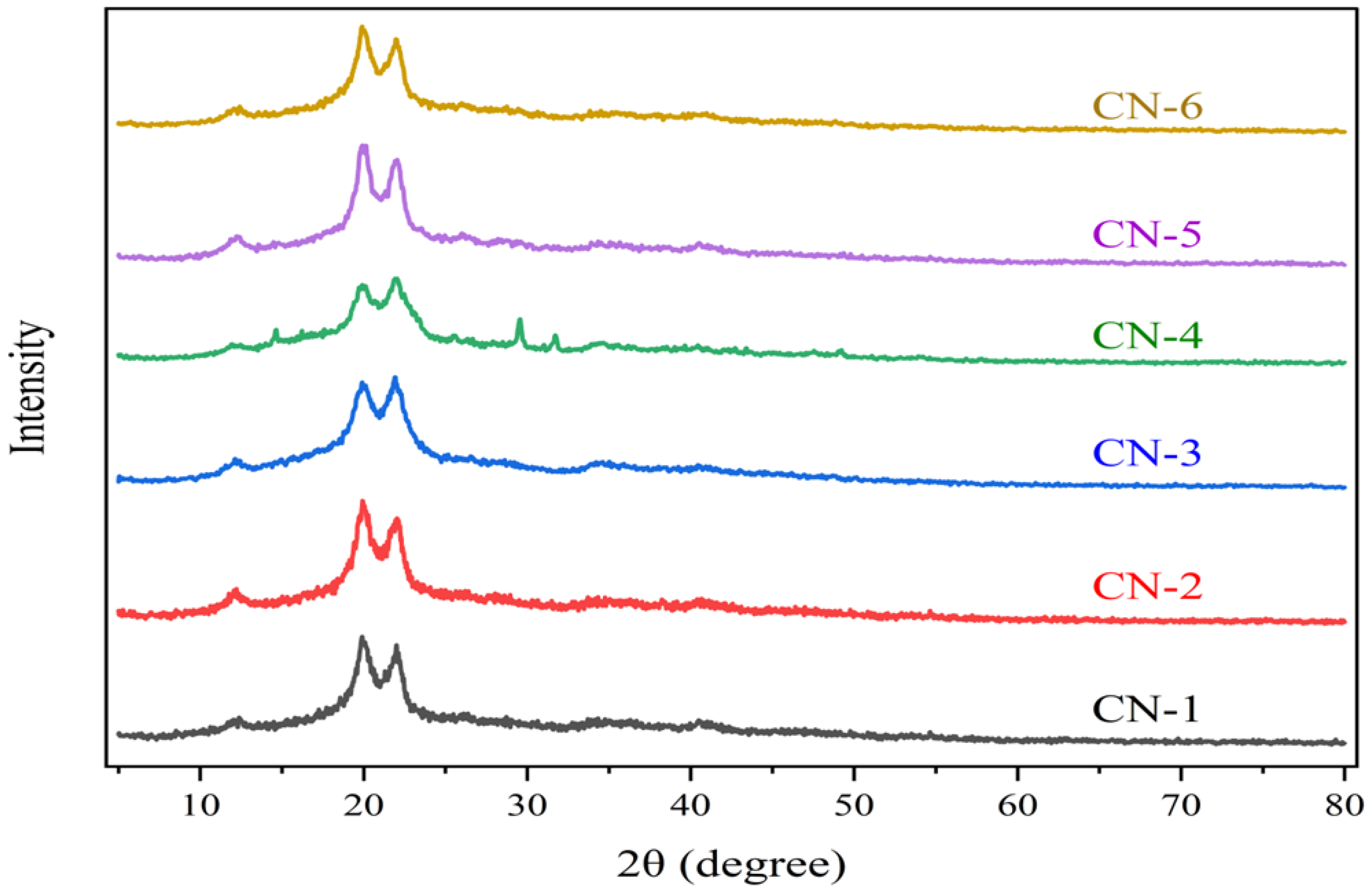
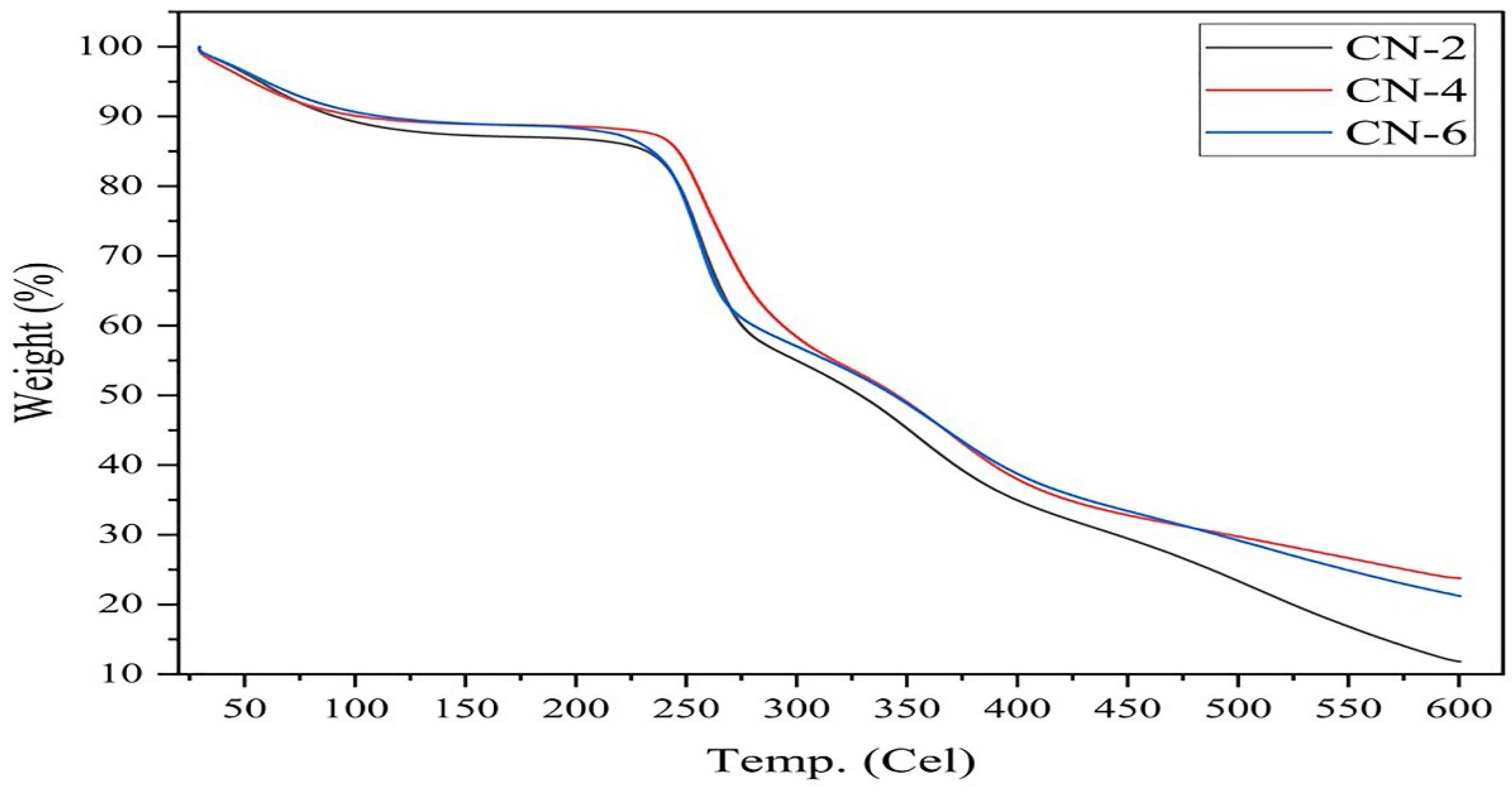

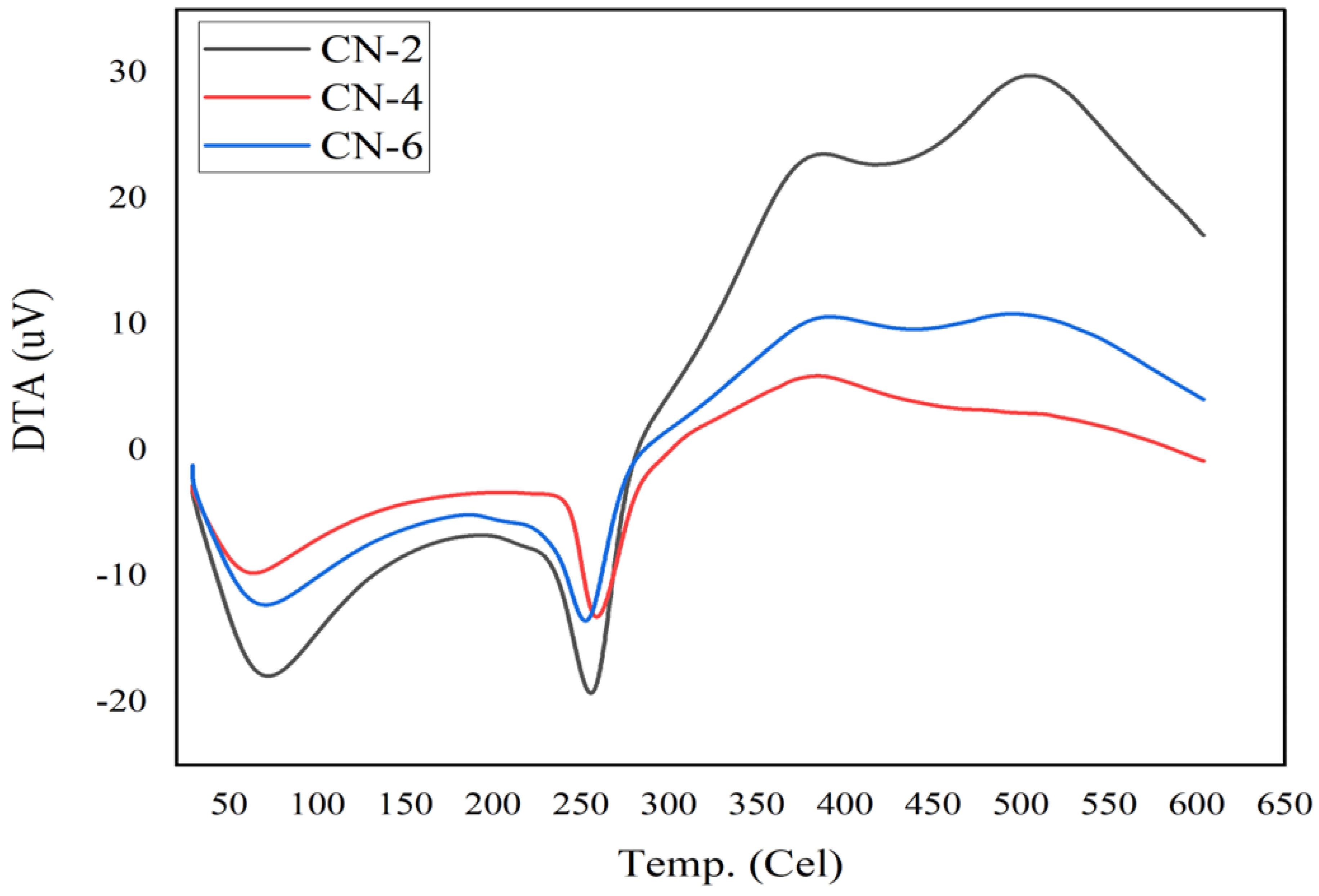

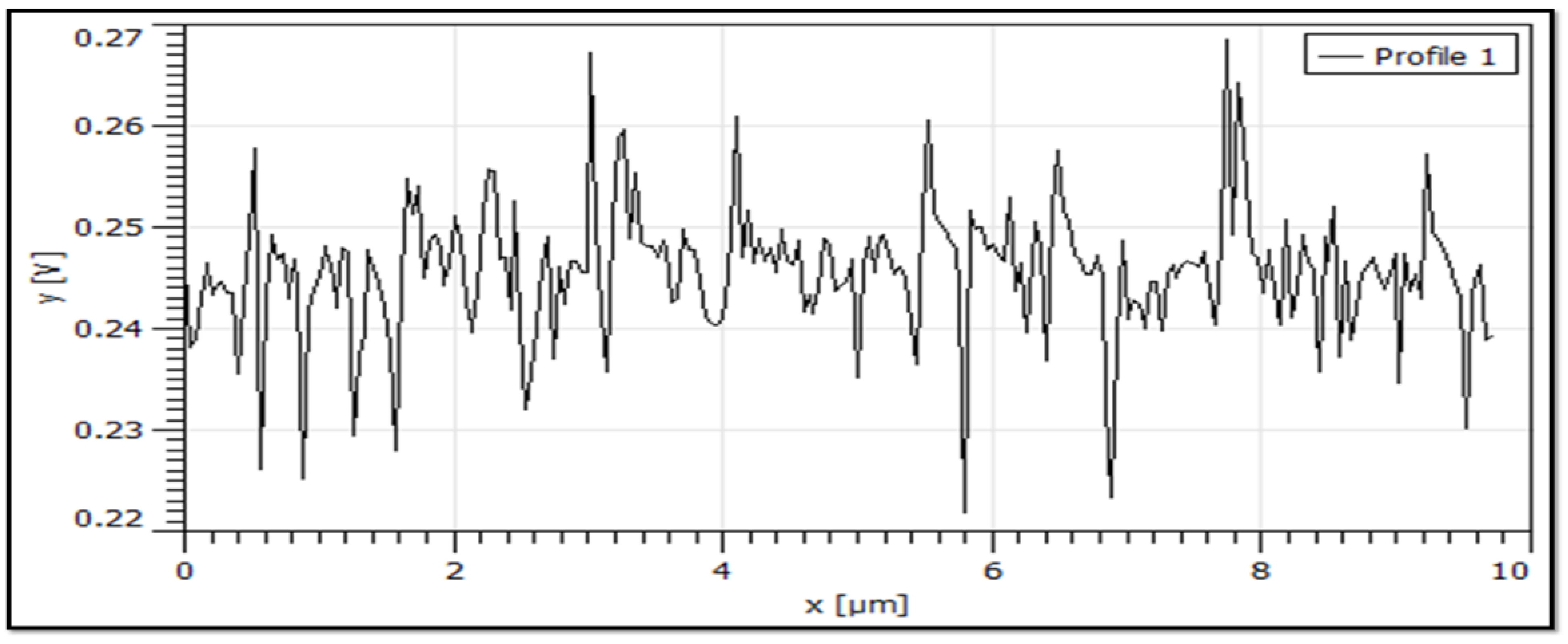

| Sample ID | Reaction Time | Concentration of H2SO4 (%) | Length of Particle Size | Zeta Potential | % Yield |
|---|---|---|---|---|---|
| CN-1 | 20 min | 58% (17.431 N) | 1208 nm | −0.912 mV | 63.47 |
| CN-2 | 45 min | 890 nm | −28.6 mV | 57.29 | |
| CN-3 | 20 min | 60% (18.294 N) | 973 nm | −1.02 mV | 60.16 |
| CN-4 | 45 min | 805 nm | −26.9 mV | 51.49 | |
| CN-5 | 20 min | 62% (19.178 N) | 785 nm | −1.61 mV | 54.23 |
| CN-6 | 45 min | 698 nm | −36.6 mV | 41.16 |
| Sample ID | 2θ (Degree) | Crystallinity Index | Crystallite Size |
|---|---|---|---|
| CN-1 | 12.23, 20.03, 22.01 | 80.68% | 3.052 nm |
| CN-2 | 12.21, 19.97, 21.96 | 90.24% | 3.765 nm |
| CN-3 | 12.07, 19.93, 21.92 | 79.73% | 2.705 nm |
| CN-4 | 11.89, 19.82, 21.96, 29.55, 31.69, 34.4 | 84.35% | 3.765 nm |
| CN-5 | 12.14, 17.8, 19.91, 21.97, 35.2, 40.64 | 89.4% | 4.560 nm |
| CN-6 | 11.91, 20.01, 22.04 | 90.91% | 4.270 nm |
| Sample | Ti (°C) | Tmax (°C) | Residue (wt%) | DTG (mg/min) at Tmax |
|---|---|---|---|---|
| CN-2 | 202.1 | 258.6 | 12.0 | 1.632 |
| CN-4 | 197.6 | 261.9 | 23.7 | 0.914 |
| CN-6 | 192.4 | 257.7 | 21.6 | 1.309 |
| Sample ID | Reaction Time | % Concentration of H2SO4 | Temp °C | DTA uV |
|---|---|---|---|---|
| CN-2 | 45 min | 58% (17.431 N) | 71.08668518 | −17.93228135 |
| 255.9306183 | −19.27960668 | |||
| 419.8621521 | 22.70405841 | |||
| CN-4 | 45 min | 60% (18.294 N) | 65.72425079 | −9.754850507 |
| 259.4009399 | −13.23660767 | |||
| CN-6 | 45 min | 62% (19.178 N) | 71.50741577 | −12.28114557 |
| 253.3040009 | −13.54624414 | |||
| 435.6995239 | 9.605033398 |
Disclaimer/Publisher’s Note: The statements, opinions and data contained in all publications are solely those of the individual author(s) and contributor(s) and not of MDPI and/or the editor(s). MDPI and/or the editor(s) disclaim responsibility for any injury to people or property resulting from any ideas, methods, instructions or products referred to in the content. |
© 2023 by the authors. Licensee MDPI, Basel, Switzerland. This article is an open access article distributed under the terms and conditions of the Creative Commons Attribution (CC BY) license (https://creativecommons.org/licenses/by/4.0/).
Share and Cite
Rana, M.S.; Rahim, M.A.; Mosharraf, M.P.; Tipu, M.F.K.; Chowdhury, J.A.; Haque, M.R.; Kabir, S.; Amran, M.S.; Chowdhury, A.A. Morphological, Spectroscopic and Thermal Analysis of Cellulose Nanocrystals Extracted from Waste Jute Fiber by Acid Hydrolysis. Polymers 2023, 15, 1530. https://doi.org/10.3390/polym15061530
Rana MS, Rahim MA, Mosharraf MP, Tipu MFK, Chowdhury JA, Haque MR, Kabir S, Amran MS, Chowdhury AA. Morphological, Spectroscopic and Thermal Analysis of Cellulose Nanocrystals Extracted from Waste Jute Fiber by Acid Hydrolysis. Polymers. 2023; 15(6):1530. https://doi.org/10.3390/polym15061530
Chicago/Turabian StyleRana, Md. Sohel, Md. Abdur Rahim, Md. Pervez Mosharraf, Md. Fazlul Karim Tipu, Jakir Ahmed Chowdhury, Mohammad Rashedul Haque, Shaila Kabir, Md. Shah Amran, and Abu Asad Chowdhury. 2023. "Morphological, Spectroscopic and Thermal Analysis of Cellulose Nanocrystals Extracted from Waste Jute Fiber by Acid Hydrolysis" Polymers 15, no. 6: 1530. https://doi.org/10.3390/polym15061530
APA StyleRana, M. S., Rahim, M. A., Mosharraf, M. P., Tipu, M. F. K., Chowdhury, J. A., Haque, M. R., Kabir, S., Amran, M. S., & Chowdhury, A. A. (2023). Morphological, Spectroscopic and Thermal Analysis of Cellulose Nanocrystals Extracted from Waste Jute Fiber by Acid Hydrolysis. Polymers, 15(6), 1530. https://doi.org/10.3390/polym15061530









